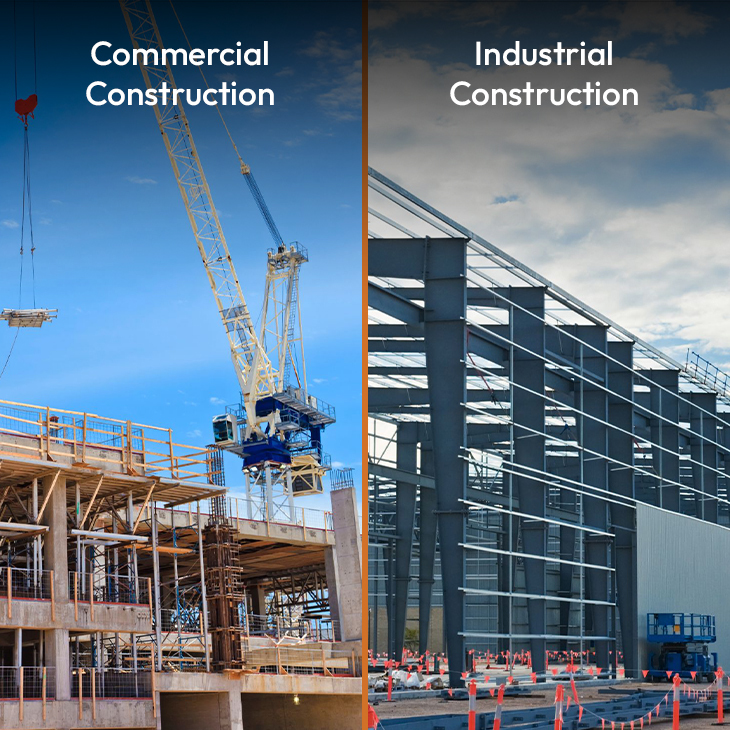
For a layman, commercial and industrial construction sites may seem to be the same. They may be unable to distinguish between them due to some similarities, but many factors make them different.
The permitting process, location, design and style of both constructions differ, but some people may use the terms interchangeably. Knowing some unique attributes and structures of industrial and commercial construction can help you differentiate between them. Let’s dig deeper to understand their differences and avoid mixing the two terms in the future.
Also Read: Questions You Should Ask Before Hiring A Commercial Construction Company
Permitting Process
All big construction companies require permits to carry out the construction process. Even signing may draw the legal attention of local authorities in some areas. Commercial building permits often concentrate on zoning restrictions, general safety and occupancy requirements. Once the requirements are fulfilled, a business can easily open its doors.
Compared to commercial buildings, industrial sites have more compliance requirements that must be considered. They become critical if the company handles or manufacturers hazardous materials. To fulfill all the requirements, it may take weeks or months to process. Moreover, these requirements may need to be necessitated with specialized building construction services.
Site Planning
Once construction companies get the green light, that is, the permit to start the work, then you can create a plan for how construction will proceed. The lead contractor will meet with their clients at this stage to determine their requirements and concerns. Doing so helps the engineers to determine the best possible solutions and helps to fulfill their needs.
Both commercial and industrial constructions are aimed to reduce the impact of their effects on daily operations. The only difference is how commercial development site planning emphasizes keeping enterprises open to the public and presentable to customers. Industrial sites are less interested in appearance and are interested in logistics, like the distribution of power usage.
Design Process
The construction design process is often the project’s most exciting part for both clients and contractors. It allows both parties to put their needs and requirements together to come up with ideas and bring them to life. But the design language used by the clients or the public will differ from industrial design language.
Traffic flow is vital for both types of construction, but the reasons for them are quite different. Commercial building sites must prioritize a simple, efficient traffic flow to increase client dwell time and promote lingering.
A industrial construction floor layout design emphasizes the following:
- Enhanced productivity
- Keeping a steady traffic flow
- Improved efficiency
Infrastructure Support
Commercial sites do not differ very much from how homes are constructed. Some commercial sites, such as nursing homes, apartments and hotels, are built for short or long-term residential use. The infrastructure of commercial buildings usually contain HVAC systems that can control small ecosystems within larger systems; some provisions for higher power usage are standard infrastructure components.
Both construction types need robust supporting infrastructure to meet all of the requirements and have firm foundations. This not only includes the provision of massive power consumption but also the inclusion of waste management. These requirements have a very strong impact on the material change and the expertise required to build them.
Project Management
Most project managers can easily handle average constriction sites. The contractors they hire can also be very similar to those who can manage large residential projects. For example, project managers can concentrate on hiring the right professional plumbers, interior designers and electricians to get the job done well.
Although both construction types require almost the same set of skills, industrial sites also require different specialized and advanced skills. These requirements may include equipment assembling, custom fabrication and large-scale installation. Project managers should be able to handle complex logistics systems. Like when a plant has overgrown its area and needs to be relocated.
About Taurus
Taurus is an accredited construction company based in Fort Saskatchewan. We have a group of highly qualified and knowledgeable builders. Taurus Projects takes great pride in its team of expert construction professionals who strive to provide our clients with first-rate construction services. We oversee all kinds of construction projects, from material management to site services. Learn more about Taurus here.
For professional construction management services, contact us now.